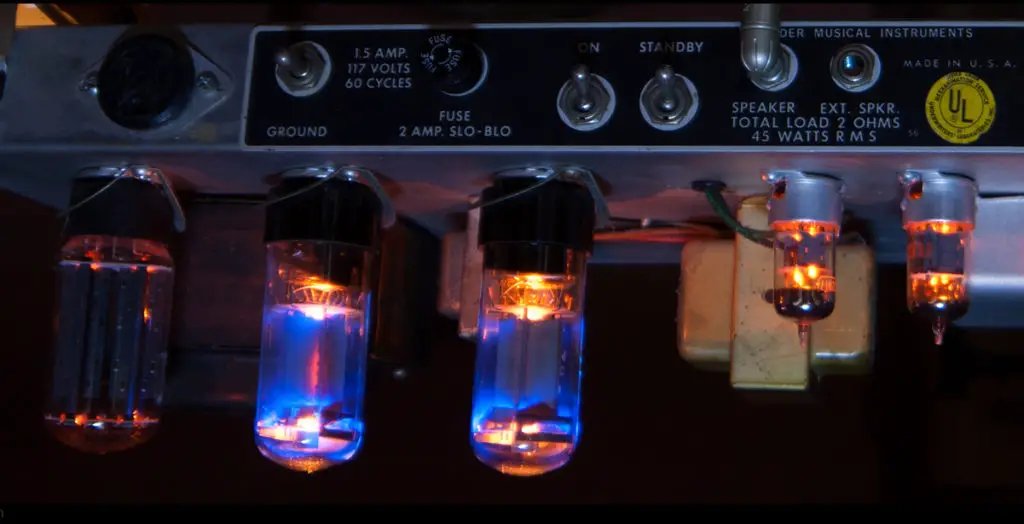Tube amps are a type of amplifier that uses vacuum tubes to amplify sound. They are often considered to have a warmer, more natural sound than other types of amplifiers, but they also require a longer warm-up time before they are ready to use.
Do tube amps need to warm up?
Tube amps generally need to warm up for a few minutes up to an hour before reaching their optimal sound quality. The warm-up is necessary because the vacuum tubes inside the amp need time to heat up to their operating temperature.
Tube amps may take a few seconds or minutes to start producing sound but can take up to half an hour or a full hour to reach their optimal sound quality.
Once they are up to temperature, they will provide the best sound and performance. Many users describe the sound as having a rich, full, and creamy tone.
Until the tube is thoroughly heated, the amp may not sound as good and may even be a bit noisy.

Why Do Amplifiers Need to Warm Up?
Vacuum tubes, also known as thermionic valves, are devices that rely on heat in order to work correctly. Hence the prefix “Therm”, which comes from Greek, where it has the meaning “heat,” and the suffix “ionic,” which means it has to do with ions.
You can check out the definition here if you don’t believe me: https://www.wordreference.com/definition/therm
Ions are particles with electric charges. In the case of the vacuum tube, these are negatively charged particles called electrons.
Okay, so how does this relate to the amplifier warming up?
The vacuum tube amplifier needs to warm up because the tubes need to heat up to their operating temperature. When the tubes are cold, they are not able to produce sound. Solid-state amplifiers do not need time to warm up, as they use semiconductors instead of vacuum tubes.
Vacuum tubes use thermionic emissions to amplify the signal coming into the amp. You can read more about that on Wikipedia here.
How Does a Vacuum Tube in a Tube Amplifier Work?
A vacuum tube is a device used to amplify or distort electronic signals. (The properties of when the signal gets distorted is one of the reasons guitarists love tube amps.)
The vacuum tube consists of a glass or metal tube with electrodes at each end. The electrodes are called the cathode and the anode.
The cathode is heated by a filament, which causes it to emit electrons. The time it takes the cathode to heat up is why tube amps take time to warm up. The cathode does not emit electrons when cold, and as it heats up, electrons are radiated more freely.
The electrons are drawn to the anode, where they are accelerated and collide with the anode. This collision creates the desired amplification or distortion. To learn more about how the input signal is amplified, check out this Wikipedia article here.
In between the cathode and the anode is what is called the control grid, or “grid” for short.
The grid between the cathode and anode acts as a valve, controlling the flow of electrons from the cathode to the anode. The voltage on the grid is used to control the current flowing through the tube, and hence the loudness of the sound produced.
The input signal from your guitar is what controls the voltage on the grid. Again, Wikipedia has an entire article on the topic found here.
Here’s the schematic symbol for a triode vacuum tube. I like it because you can picture how it works. The cathode is heated, and electrons pass from the cathode through the control grid to the anode plate.

How Long Does It Take For An Amplifier To Warm Up?
It can take anywhere from a few minutes to an hour for a tube amplifier to warm up fully. The time it takes will depend on the type of amplifier and the ambient temperature and humidity. Larger, more powerful amplifiers will take longer to warm up than smaller ones.
Tube amps are able to produce some sound in only a few minutes, but the sound characteristics will be different than when the tube is fully warmed up.
How Long Should I Run My Tube Amp?
A vacuum tube can be left on without burning out or causing damage for an indefinite amount of time as long as it is not overloaded. Vacuum tubes used in amplifiers generally last 10,000 hours at most.
Ten thousand hours is a lot of playing time. If you left your amp on until the tube burned out, it would last approximately 416 days (10,000-hour tube life ÷ 24 hours in a day). Most people won’t do that.
More common usage of 24 hours over a month means your vacuum tubes should last for decades.
Now, I did mention overloading. A vacuum tube can be overloaded if too much current passes through it. That means having your guitar turned up all the way and the signal also being amplified before getting to the tube.
Vacuum tubes are often set up in series, meaning your input signal will pass from one to the next and get amplified more at each stage. So overloading is most likely to occur later down the chain.
When a vacuum tube is overloaded or operated past its design dissipation, its anode (plate) may glow red. In consumer equipment, a glowing plate is universally a sign of an overloaded tube. However, some large transmitting tubes are designed to operate with their anodes at red, orange, or in rare cases, white heat.
Wikipedia
All that said, the tube’s life span should probably be the least of your concerns.
As you know, vacuum tubes get extremely hot. The problem with leaving your amp on for a really long time is the buildup of that heat and how it impacts other parts of the amplifier.
Leaving your amp on for a long time can lead to heat buildup, which can cause problems like melted plastic connectors and weakened solder joins.
What Happens If An Amplifier Is Not Warmed Up?
The tubes work because the cathode is heated up so hot that electrons start falling off or being boiled off; it creates a heat source that boils electrons off the surface. The electrons are then pulled to the anode by the voltage difference between the cathode and the anode.
The only way you can damage a tube amp is by applying so much voltage to the vacuum tube that you create a high-current flow that damages the electron emitter (cathode). With a properly designed amplifier having speakers with correctly matched impedance connected, it should be impossible to damage the tubes with over-voltage.
The risk of physical damage is negligible if you try to play in the few seconds before the cathodes heat up. If the cathodes aren’t emitting electrons, you simply will not get any sound when you play.
Do Solid-State Amps Need To Warm Up?
In general, solid-state amps do not need to warm up in the same way that tube amps do. No warm-up is required because solid-state amps do not rely on vacuum tubes, which need to be warmed up in order to achieve their optimal sound. Instead, solid-state amps use transistors, which do not require a warm-up period.
Summary
Tube amps generally need to warm up for a certain amount of time before reaching their optimal sound quality. This is because the vacuum tubes inside the amp need time to heat up to their operating temperature.
Tube amps may take a few seconds or minutes to start producing sound but can take up to half an hour or a full hour to reach their optimal sound quality.
Once they are up to temperature, they will provide the best sound and performance. Many users describe the sound as having a rich, full, and creamy tone. Until the tube is thoroughly heated, the amp may not sound as good and may even be a bit noisy.
Solid-state amps do not need to warm up in the same way that tube amps do. Solid-state amps use transistors, which do not require a warm-up period.
Wikipedia was an excellent resource for me. They have a lot of articles on the topic, which can make it overwhelming. Check out these articles:


